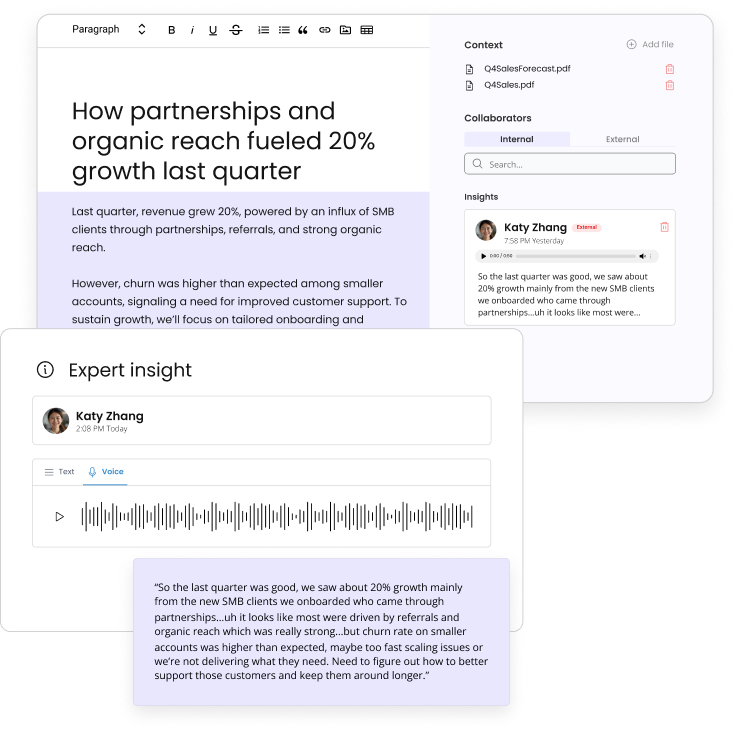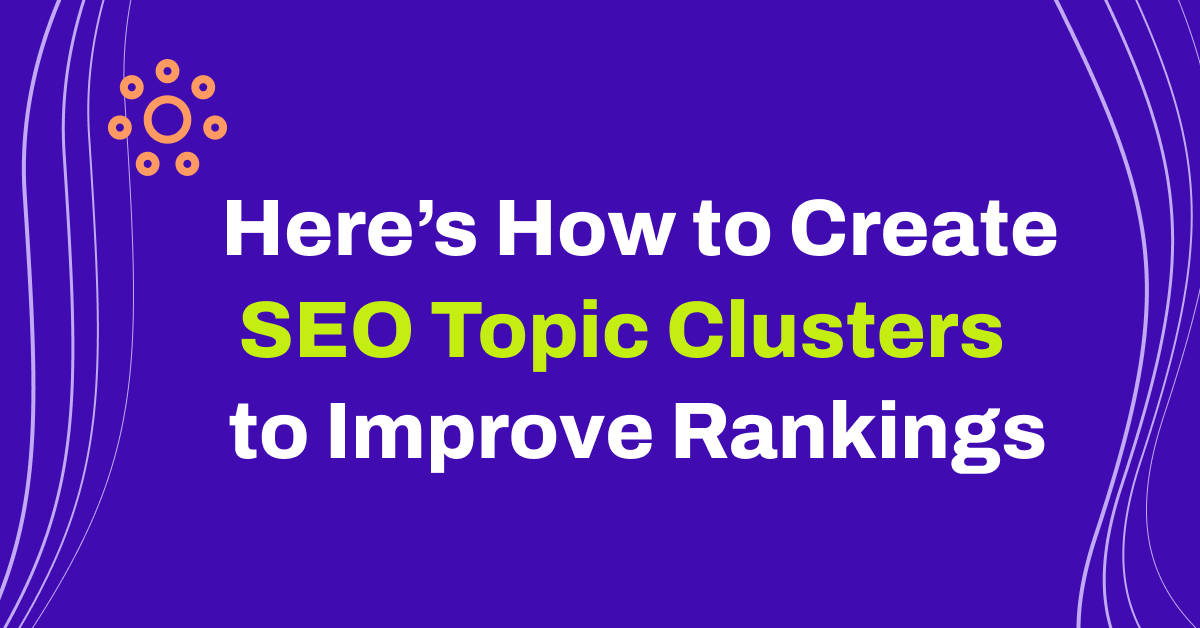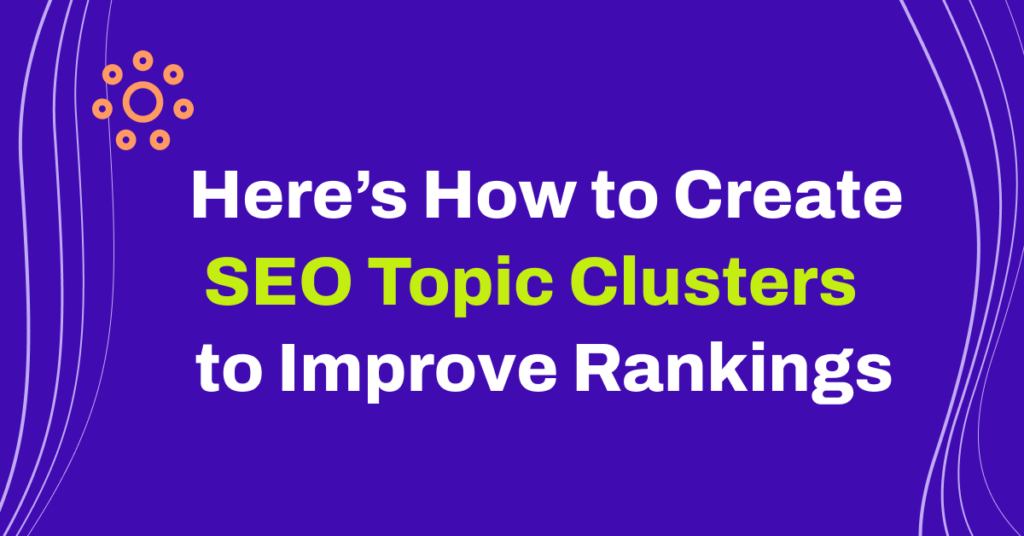Table of Contents

Authority scales when expertise comes first
Wordbrew helps teams collect expert insight before AI ever writes a word.
Built for expert-led, review-safe content
- Home
- »
- Content Marketing
- »
- What Are SEO Topic Clusters and How Do They Help Your Site Rank?
-
Stacy Garrels
- 9 minutes read time
What Are SEO Topic Clusters and How Do They Help Your Site Rank?
- Home
- »
- Content Marketing
- »
- What Are SEO Topic Clusters and How Do They Help Your Site Rank?
What Are SEO Topic Clusters and How Do They Help Your Site Rank?
Table of Contents

There’s more to content creation than just churning out articles. You need to research keywords, figure out search intent, and ensure that the content is structured properly on your website so users find exactly what they’re looking for.
But how can you do all of this efficiently?
Enter: SEO topic clusters.
Topic clusters are a powerful technique to manage content by tactfully unifying content in groups or clusters. These clusters are designed to help users find answers to a variety of questions or queries related to a primary topic.
But how should you approach topic clusters and how do they help improve your site’s ranking on search engines? Let’s dive in!
TL;DR:
- SEO topic clusters revolve around Google’s BERT technology, which fills the demand for answering complex inquiries and circulating pillar content to cluster content seamlessly.
- SEO topic clusters allow better targeting of search queries, enhance user experience, increase content rank and organic traffic, and provide opportunities for internal linking.
- Create an effective SEO topic clusters by using 3 steps: Choose a central topic, create a pillar content piece, and create a cluster content.
- Ignoring user intent, weak pillar content, and overuse of internal links are SEO topic cluster common mistakes.
- Link building can help establish your website as trustworthy and credible.
- Strategizing your topics accordingly can put your content at a better placement and strengthen users’ confidence in your website.
An introduction to SEO topic clusters
In the past, SEO primarily relied on using specific keywords to optimize content for search engines. However, the advent of natural language processing (NLP) and large language models (LLMs) now allows search engines to better understand and process human language and the intent behind users’ search queries.
One of Google’s most important search algorithms of the previous decade, Google BERT, gave rise to the popularity of topic clusters.
BERT stands for Bidirectional Encoder Representations from Transformers, a neural network-based language model effective at various natural language processing (NLP) tasks, including question answering, text classification, and sentiment analysis. This language model assists users by extracting, grouping, filtering, and detecting top content on Google that relates to the question they typed in.
Today, users are more likely to type in long-form questions to find precise answers, and BERT can assist them in finding the topics via the text corpus accurately and rapidly. In short, the existence of BERT has now led to the creation of topic clusters as a new approach to SEO.

The diagram illustrates how topic modeling is divided into topic clusters.
So, how is all of this related to content and SEO?
Well, a topic cluster is an organized collection of content around a central topic or idea. This content creation method involves creating a central “pillar” of content and linking it to a series of complimentary “cluster” content surrounding the same topic. This helps search engines better understand your content’s relevance and authority.
Not just that, topic clusters also help to organize your website’s content logically and intuitively. This will improve users’ navigation on your site and simplify finding information.
Besides, topic clusters enable you to target a wide range of long-tail keywords related to your central topic. Long-tail keywords are typically less competitive than broader keywords, which means that the chances of getting the content ranked are higher.
So by creating a comprehensive pillar piece and a series of complimentary cluster content, you can establish your website as an authority on a particular topic and drive more targeted traffic.
What benefits do SEO topic clusters offer?
Topic clusters have become an increasingly popular SEO strategy for many good reasons. Here are some benefits of incorporating topic clusters into your SEO strategy:
Better targeting of search queries:
You can ensure your content is more focused and targeted towards specific search queries. This can help increase the chances of your content appearing higher in relevant search engine results.
For example, if you have a website that sells pet supplies, you might create a topic cluster around “dog food.” This cluster includes a central pillar page that provides an overview of different types of dog food and several associated cluster pages that cover specific types of dog food, such as “grain-free dog food” or “organic dog food.”
Improved user experience:
You can improve the user experience by making it easier for users to find the content they’re looking for on your website. This can lead to increased engagement and a lower bounce rate. You can establish your website as a go-to resource for interested users by providing comprehensive information on a particular topic. This can increase brand awareness and loyalty.
Increased authority:
With high-quality and comprehensive content around a central topic, you can establish yourself or your brand as an authority in your field. This can increase trust and credibility with your audience. By linking your cluster pages back to your pillar page, you can signal to search engines that your website is a valuable resource on that topic, leading to higher search engine rankings and increased organic traffic.
Opportunities for internal linking:
Topic clusters provide internal linking opportunities that help improve your website’s overall structure and organization. It creates a clear flow of hierarchy information that makes it easy for users to navigate your website. Thus, internal linking can help distribute link equity throughout your website, improving the overall authority and ranking potential of your website.
How do topic clusters help improve rankings?
Topic clusters are an effective way to boost your website’s ranking on search engines. They help you organize your content and establish authority on a particular subject. By creating a cluster of interconnected content focused on a specific topic, you can provide a more comprehensive resource for your audience and improve your website’s visibility in search results.
The key benefits of using topic clusters are:
- They can help you create more targeted content.
Allows you to create content more targeted to your audience’s needs. Grouping related content can provide a more in-depth exploration of a particular topic, giving your readers a complete understanding of the subject matter. - They can improve your website’s SEO.
Linking related content together can create a web of internal links that search engines can use to understand the structure and hierarchy of your website. This can help search engines better understand your content’s relevance and authority, leading to higher rankings in search results. - They have the potential to increase traffic to your website.
Creating a comprehensive resource on a particular topic can attract a wider audience of interested people. This can increase your website’s visibility and attract more visitors.

The diagram illustrates how internal linking in your content circulates on your website.
Incorporating topic clusters into your SEO strategy can help improve targeting, user experience, authority, and organization. By creating high-quality, comprehensive content around a central topic, you can establish yourself or your brand as a go-to resource and attract more organic traffic to your website.
How to create an effective SEO topic cluster
Creating an effective SEO topic cluster involves several key steps.

The diagram illustrates how pillar content links to cluster content via hyperlinks (the grey colored arrows).
- Choose a central topic:
When creating a topic cluster, it’s important to start with your pillar content. This should be a comprehensive piece of content that covers all aspects of your chosen topic. You can then create a series of clusters of content that expand on specific subtopics related to your central theme. Each content cluster should link to your pillar page and vice versa.
Brainstorm a list of potential central topics or ideas you want to create content around. This could be a product, service, industry trend, or any other topic related to your business. Once you have a list, narrow it down to the topic that will provide the most value to your audience and has the most potential for subtopics.
- Create a pillar content piece:
Secondly, you’ll need to create comprehensive content (often a blog post or article) that thoroughly overviews the topic. This piece should be the anchor of your SEO topic cluster and should link to all the associated cluster content.
You can start by creating a pillar content piece that is relevant to your target audience, stays in your niche, and doesn’t go off track. Produce something that is evergreen so that people can visit your content again and again, be it on social media or in a newsletter. Give your content the publicity they need, the publicity you think your content deserves to have.
- Create cluster content:
Next, you can create a series of content clusters that delves deeper into specific subtopics related to your central topic. Each piece of content in a cluster should be linked to the pillar content and other content within the same cluster. Some people might also refer to pillar content as 10x content however the approach for both is different.
When creating your cluster content, use various media types and formats to keep the content fresh and engaging. You should optimize each piece of content for SEO by including relevant keywords and meta descriptions.
You must be mindful that topic clusters are not limited to blogs or articles. It could be in the form of infographics, videos, podcasts, ebooks, and more. No matter which content format you choose, ensure it is engaging, relevant, and informative.
By following these steps, you can create an effective SEO topic cluster that will help improve your search engine rankings and provide value to your audience.
Common mistakes to avoid with SEO topic clusters
Topic clusters have become one of the most popular SEO strategies. They allow you to organize your content around specific topics and improve your website’s visibility in search engine results pages (SERPs). However, some common mistakes can hinder the success of your topic clusters.
Ignoring user intent:
User intent is why a user searches for something. Basically, once they click on the Google Chrome icon, Safari icon, or other web server icons, they are on a mission – to find information, pronto. There are 3 types of user intent:
- Informational intent: the user wants to learn something. They might want to learn something new, do some research, or ask a question.
- Transactional intent: the user searches for a specific service or product. They may be ready to make a purchase, read reviews, or compare prices.
- Navigational intent: the user is looking for a specific website. They may type in the exact website address or browse websites that offer the service or product they are looking for.
Keywords used in a search query can be used to identify a user’s intent. For instance, a user who searches for “how to bathe a cat” has informational intent. A user who searches for “best cat shampoo” has transactional intent. And a user who searches for “cat lovers online community” has navigational intent.
Once the user intent is identified, you can create content that addresses your target audience’s needs and interests. For example, if a user seeks information on how to bathe a cat, you can write a blog post or record a video that provides step-by-step instructions. If a user wants to purchase a cat shampoo, you can create a product page that includes information about the product, such as the price, the reviews, and the ingredients.
This will improve the effectiveness of your topic cluster and the overall user experience on your website. Conduct thorough keyword research and create content that aligns with the search intent of your target audience.
Weak pillar content:
If your pillar content is weak, your topic cluster won’t be as effective. Make sure to put enough time and effort into creating high-quality content to anchor the cluster. This will improve the effectiveness of your topic cluster and establish your website as an authority on the topic.
Overuse of internal links:
Too many internal links can make your content seem spammy and have an adverse effect on your content. For instance, do not link to multiple pages within the same paragraph as it can be confusing for users.
Secondly, link only to relevant content and use descriptive anchor text to describe the linked content accurately. Another tip is to avoid making your content look cluttered and overwhelming by linking to other pages on every page of your website. Let’s keep it minimalist-ly pleasant to the eyes and keep relevant information intact.
To sum up, topic clusters can be a highly effective SEO strategy, but it’s important to avoid these common mistakes. By creating strong pillar content, using internal links strategically, and understanding user intent, you can create a successful topic cluster that improves your website’s visibility in search engine results pages.
The role of link building in SEO topic clusters
Link building is acquiring hyperlinks from other websites to your own. These hyperlinks, also known as backlinks, are essential “votes” of confidence from other websites that your content is valuable and trustworthy. This tactic is also one of the key strings in a content distribution strategy.
When it comes to SEO topic clusters, link building can help establish your website as an authority in your niche. By earning high-quality backlinks from other authoritative websites, search engines view your site as more trustworthy and credible. This, in turn, can lead to higher rankings on search engine results pages (SERPs).
However, not all backlinks are created equal. Some backlinks can hurt your website’s ranking if they come from low-quality or spammy websites. That’s why it’s important to focus on earning high-quality backlinks from reputable websites relevant to your niche.
Here are 2 effective strategies to earn high-quality backlinks:
- Creating valuable, shareable content that other websites want to link to
This could include blog posts, infographics, videos, and other types of content that provide value to your target audience. - Reach out to other websites in your niche and offer guest posts on their site
This can be a great way to earn a backlink while establishing yourself as an authority in your niche.
Ultimately, effective link-building requires a thoughtful and strategic approach. It should be implemented naturally, in that it does not disrupt the flow of the content. Strategically planning your link placement makes your content look and feel professional and makes the content safe to explore.
In short, topic clusters are more user-centric, provide great opportunities to improve site architecture, and reduce the chances of keyword cannibalization. Plus, it reduces the time spent creating content by providing a framework for you to follow, improves the quality of the content by ensuring it is informative and comprehensive, and increases engagement by providing a variety of ways for visitors to learn.
Need help implementing a topic cluster strategy to boost your online presence and improve your SEO? Wizeo‘s subject matter experts are here to help create the content your brand deserves. Launch a pilot project today, and we’ll get you on your way to making content your competitive advantage!
